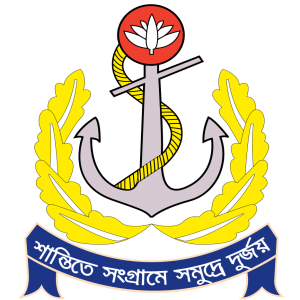
The Bangladesh Navy (Bengali: বাংলাদেশ নৌবাহিনী; Bangladesh Nou Bahini) is the naval warfare branch of the Bangladesh Armed Forces, responsible for Bangladesh's 118,813 square kilometres (45,874 sq mi) of maritime territorial area, and the defence of
important harbours, military bases and economic zones. The primary role of the Bangladesh Navy is to protect the country's economic and military interests at home and abroad. The Bangladesh navy is also a front
line disaster management force in Bangladesh, and participates in humanitarian missions abroad. It is a key regional player in counter terrorism efforts, and engages in global peacekeeping with the United Nations.
History:
The Bangladesh Navy was created as part of Bangladesh Forces during Bangladesh's 1971 liberation war against Pakistan. Its official creation
date is July 1971 during the Bangladesh Sector Commanders Conference 1971. In 1971, with West Pakistan imposing a brutal military crackdown in East Pakistan, the Bangladesh Liberation War was already underway. Many
Bengali sailors and officers in the Pakistan Navy defected to form the nascent Bangladesh Navy. Initially, there were two ships, PADMA and PALASH, and 45 navy personnel. On 9 November 1971, the first naval fleet,
consisting of six small patrol vessels, was inaugurated. These ships tried to carry out raids on the Pakistani fleet, but were mistakenly hit and sunk by the Indian Air Force on 10 December 1971. The next major
attack was launched on Mongla seaport. According to official figures from the Bangladesh Navy, a total of 334 sailors were involved with the newly created navy, with 22 being killed in action.
Branches:
Bangladesh Navy has 6 administrative branches:
-
The Executive Branch
The Executive branch is responsible for Seamanship, Navigation, Communication, Torpedo Anti Submarine, Gunnery and Hydrographic activities. -
The Engineering Branch
The Engineering branch has responsibility on board ships and at shipyard/dockyard organizations. On board ship the Engineering branch officers and sailors maintain Ships' propulsion system, power generation system, steering gear, auxiliary, ancillary and all mechanical and hydraulic systems of the ship to keep the Ship operational, ensuring its stability, sea keeping, fire fighting and damage control capabilities. At shipyard and dockyard the Engineering branch is engaged in ship repair, ship construction including renovation and new building. They are also responsible for forecasting of machinery spares, inspection & quality control and maintaining the Depot. -
The Supply Branch
The supply branch is responsible for providing supply support to ships in terms of dry and fresh rations, clothing and secretarial duties. -
The Electrical Branch
Commonly known as Electrical branch, which is responsible for distribution of power supply in the ship, maintenance of all electrical equipment, propulsion electronic control system, navigation (radar, GPS, echo sounder etc.) and communication equipment (HF sets, VHF set etc.). The major and most important part of their job is to look after the weapon and fire control system, sensors, search and fire control radars. They also contribute to the dockyards and shipyards in similar ways of the Engineering branch. -
Education Branch
The Education branch remains committed for instructional duties. Officers work in the Naval law department are also recruited for the education branch. -
Education Branch (Engineer)
The Education branch (Engineer) officers are mainly responsible for performing technological development of the Navy besides their service duties. They also perform research & development activities at CNRD & IFF Centre to enhance naval technological capabilities. -
Medical Branch
Doctors from Navy recruited directly and doctors from Army Medical and Dental cores are also seconded to the Navy for short duration to serve in the ship/establishment and in naval hospital.